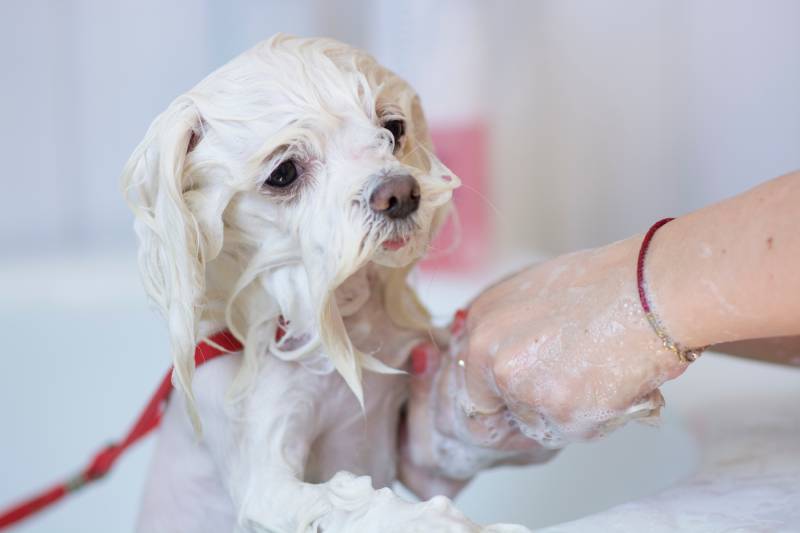Samoyed vs Pomeranian: Which One Is Right for Me? (With Pictures)
Updated on
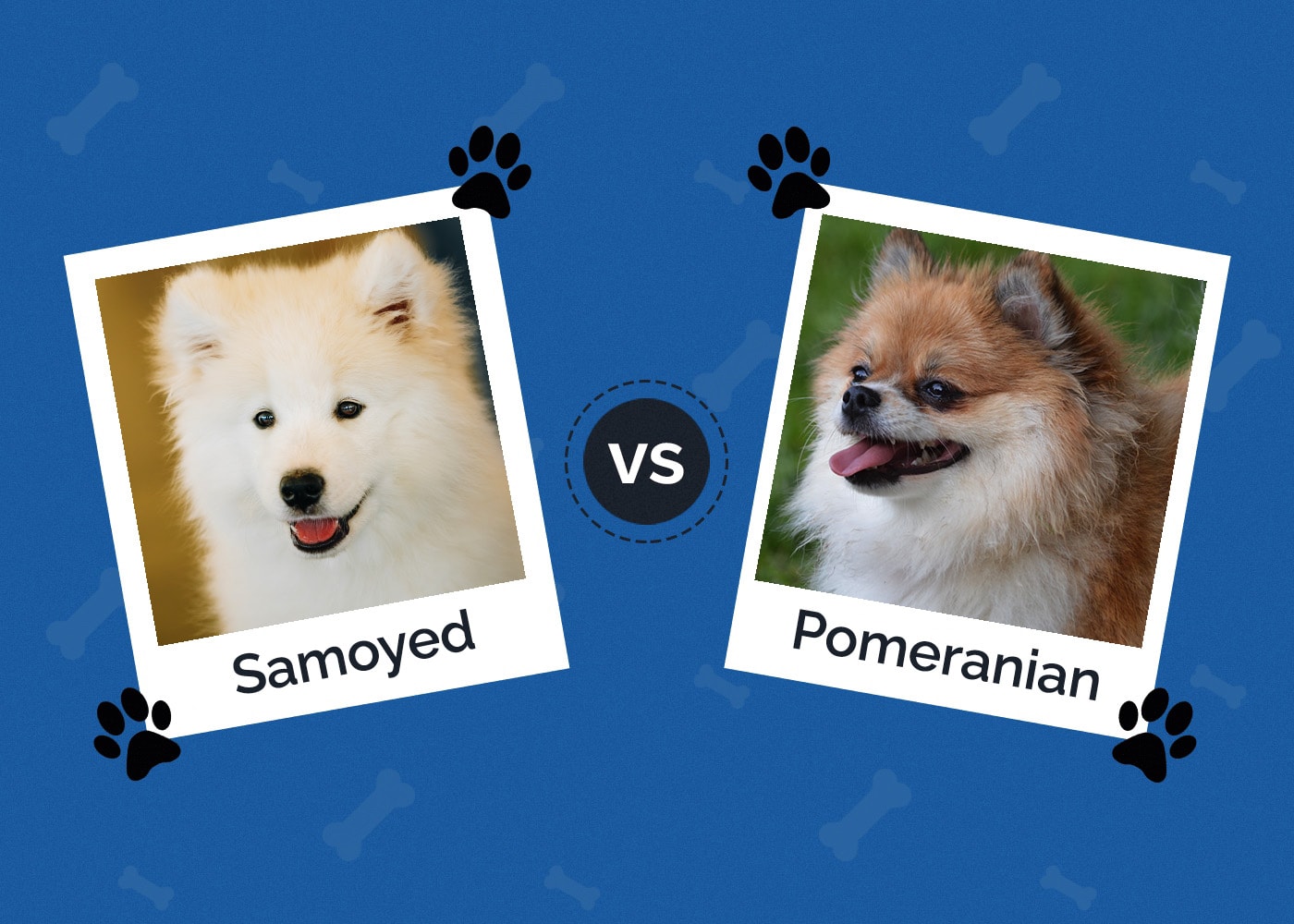
Samoyeds and Pomeranians sometimes get confused with one another due to their similar fluffy, snow-white fur, but there’s a lot that sets the two apart. While both breeds are known for their always-smiling faces and high-maintenance grooming needs, their main difference is their size and weight.
In fact, Samoyeds are approximately 14 inches taller and 42 pounds heavier than the average Pomeranian. The larger breed is also friendlier with other dog breeds than the latter. The list of their differences could go on, so it can be tricky to know which breed is right for your home.
Keep reading to learn more about the personalities, diets, health requirements, grooming needs, pros, and cons of the two breeds to make the right decision.
Visual Differences
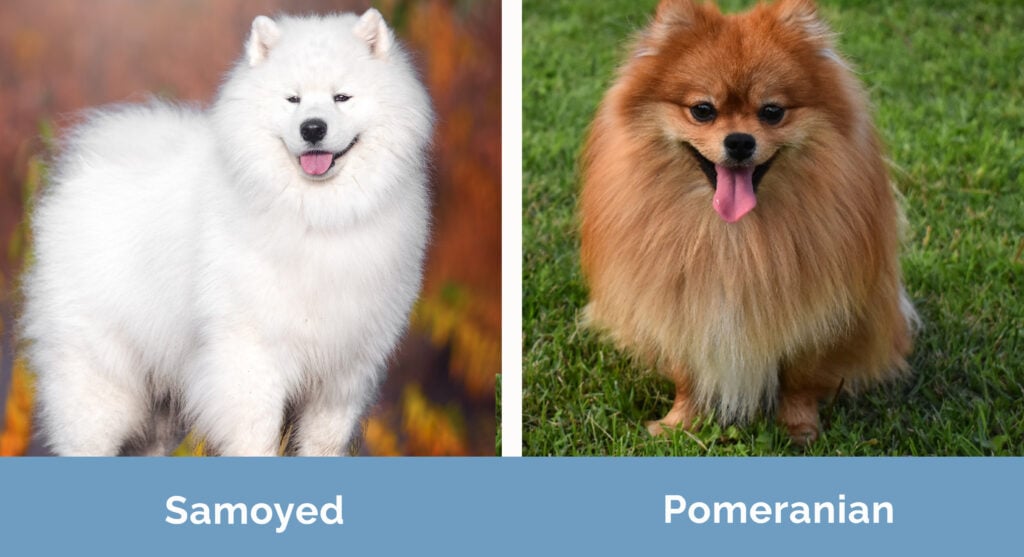
At a Glance
- Average height (adult): 21 to 23.5 inches
- Average weight (adult): 45 to 65 pounds
- Lifespan: 12 to 14 years
- Exercise: Average
- Grooming needs: High maintenance
- Family-friendly: Yes
- Other pet-friendly: Yes
- Trainability: Difficult
- Average height (adult): 7 to 12 inches
- Average weight (adult): 3 to 7 pounds
- Lifespan: 12 to 16 years
- Exercise: Minimal
- Grooming needs: High maintenance
- Family-friendly: Yes
- Other pet-friendly: Somewhat
- Trainability: Easy
 Samoyed Overview
Samoyed Overview
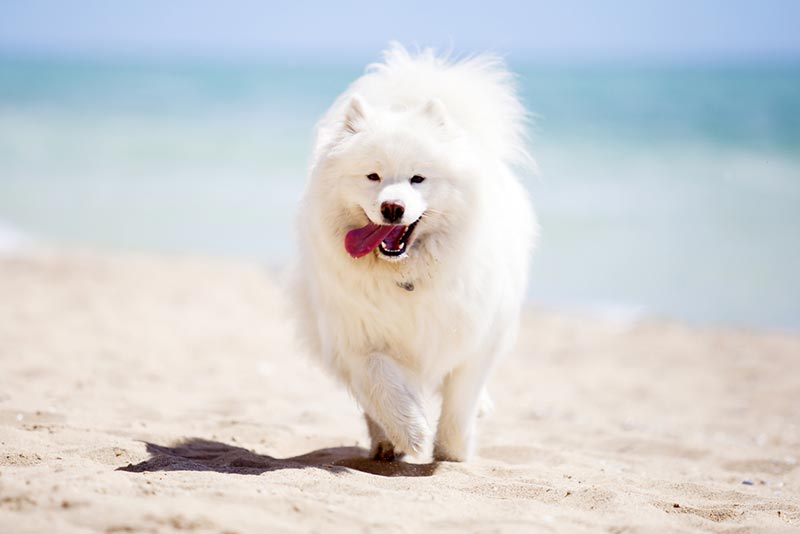
Although the Samoyed is relatively large, standing somewhere between 21 to 23.5 inches, this breed is surprisingly graceful. Better known as the smiling sled dog, the Samoyed was initially bred for work in northern climates.
Originating in Oymyakon, a small town in Siberia, these dogs are used to temperatures as low as -60°F1. They’re known for their thick white coat, which is enough to keep them warm in the coldest of weather.
Bred to work, these dogs can be powerful, tireless, agile, and impervious to cold. It may seem like their permanent smile is just a bonus to their adorable appearance, but it’s actually a practical feature. Their upturned corners help prevent drooling, which can turn into icicles in icy weather.
Personality / Character
The Samoyed is an intelligent and social dog, with its mischievous nature demanding lots of love and attention. As a result, leaving them alone and at home for too long can make them destructive and miserable.
With the proper love and training, Samoyeds can grow up to become hard-working, loyal, and protective pets. Since they are pack animals, you must train them to learn who the alpha dog is. In this case, you must be the alpha dog in the eyes of the Samoyed.
Diet
High-quality dog food is a perfectly adequate diet for a Samoyed. While commercially manufactured dog food works ideally, you can also give them home-prepared meals with approval and supervision from the vet.
You must also ensure that the home-prepared diet is appropriate to your Samoyed’s age, whether it’s a puppy, adult, or senior. Samoyeds may be prone to obesity, so we recommend monitoring their calorie consumption to maintain a healthy weight.
While training your Samoyed, you may need to leverage treats as rewards, but make sure not to give them too many. If you want to feed them human food as treats, it’s crucial to do your research to find out what’s safe for your Samoyed.
If you’re concerned about their diet or weight, it’s best to consult the vet as soon as possible. Most importantly, your Samoyed should have open access to clean and fresh water at all times.

Health and Care
Luckily, Samoyeds are known for being healthy dogs due to a history of responsible breeders. Samoyed breeders are required to test their stock for possible health conditions, such as cardiac disorders, eye diseases, or hip dysplasia.
We recommend brushing your Samoyed’s teeth often with the help of a toothpaste designed specifically for dogs. Other than that, you can ensure a long and healthy life for the dog by regularly visiting the vet for parasite control and other required checkups.
- Ophthalmologist evaluations
- Cardiac exams
- RD/OSD DNA tests
- PRA Optigen DNA tests
- Hip evaluations
Training
When Samoyeds were initially bred for work, the Samoyedic people resided in tents in frigid regions. They huddled with their dogs while sleeping to keep warm on brutal Arctic nights.
This level of closeness with their masters was uncommon for dogs in their origins, making Samoyeds more loyal to humankind than most other breeds. As a result, these dogs need a few hours of attention and affection from their owners daily.
Samoyeds can become miserable or even destructive when left alone for too long. Their social and mischievous nature demands a certain level of love and attention to keep them happy and healthy.
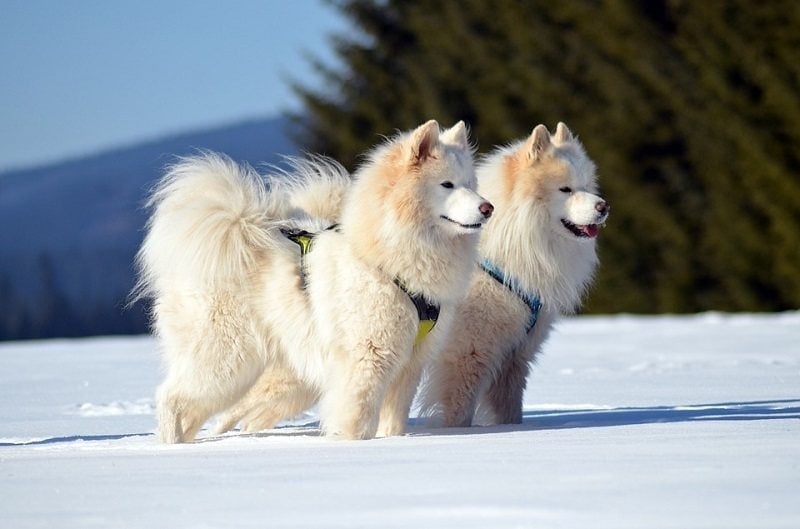
Exercise
Samoyeds are naturally active dogs, so they love to participate in family activities, go on walks, and simply spend time with their owners. These dogs need at least 2 hours of daily exercise, which can come from long on-leash walks or playing games like fetch in a fenced yard.
Being naturally free-spirited, your Samoyed may try to run away or roam, so it’s best to keep them on a fenced property.
Grooming
Samoyeds have a thick and warm double, which has kept them warm in cold weather since their origin. The outer coat is long and has harsh hair, while the undercoat is thick, soft, and wooly.
While hugging their thick and fluffy coat may feel like heaven, it also means that they shed quite a lot. If you’re not a fan of having pet hair cover every surface of your home, the Samoyed might not be the best dog for you.
During shedding season, which occurs once or twice yearly, you’ll need to constantly keep a pet hair cleaner on hand. You can reduce their shedding by brushing their coats often and taking them to the groomer monthly.
You may also use a metal comb or slicker brush to work out any tangles or mats. Finally, we recommend trimming their nails every 3 to 4 weeks.
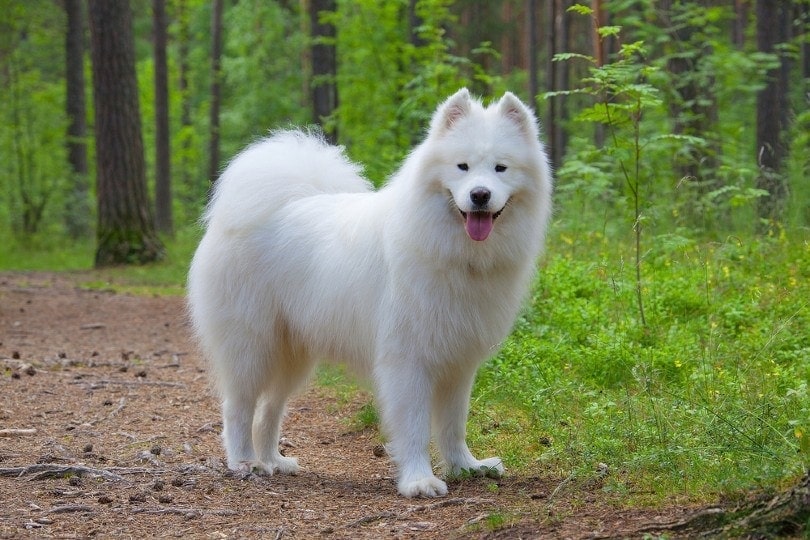
Suitable for:
Samoyeds are ideal for those who already have some experience caring for dogs. More importantly, the thick coats of these dogs only allow them to thrive in colder climates, so they’re ideal for those who live in Northern areas.
If you already have other dogs and small children, you can count on your Samoyed to get along with them and play with them every day. However, if you plan on owning a Samoyed, you’ll need to clean up after their pet hair all the time.
- Highly playful
- The ideal dog for families
- Friendly with other dogs
- Gentle and familiar with children
- Stubborn and hard to train
- Shed a lot
- Don’t do well in warm weather
- Can develop anxiety due to prolonged confinement
Pomeranian Overview
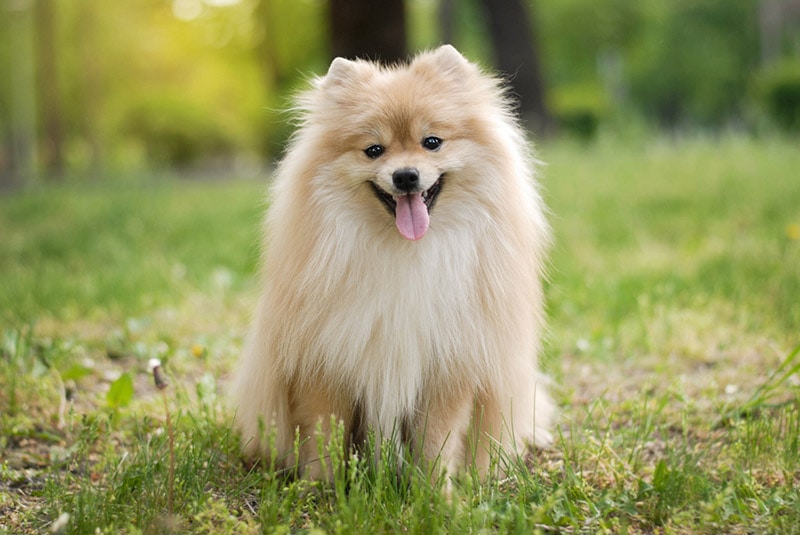
Since its origin, the small and delicate Pomeranian has been a favorite dog for royals in history. Although it has endless reasons to become one of the most famous toy dogs in the world, it’s mainly known for its luscious coat, vivacious personality, and foxy face.
This tiny pup only weighs seven to twelve pounds, but its feisty personality tells a different story. The Pomeranian loves to act like a big dog, which means you’ll hear it bark quite often. Lastly, its double coat is incredibly versatile, as it can be found in two dozen colors.
Personality / Character
Pomeranians are known for being incredibly alert and intelligent, which means training them can be a breeze. Despite their tiny bodies, their loud barks and alert minds make them the ideal watchdog for your family.
Unlike the Samoyed, the Pomeranian doesn’t need a specific climate to thrive in, as it can accommodate living in the suburbs or the city. They also don’t need much exercise, so they’re ideal for pet owners living a sedentary lifestyle.
Diet
Similar to the Samoyed, the Pomeranian can thrive on a high-quality dog food diet. Commercially manufactured dog food is ideal, but you may opt for home-prepared meals with the approval and supervision of the vet.
Monitoring their calorie consumption and weight will allow you to ensure your Pomeranian doesn’t become obese, which can be painful for a dog their size. Training these dogs becomes even easier with the help of treats, but make sure not to give them too many.
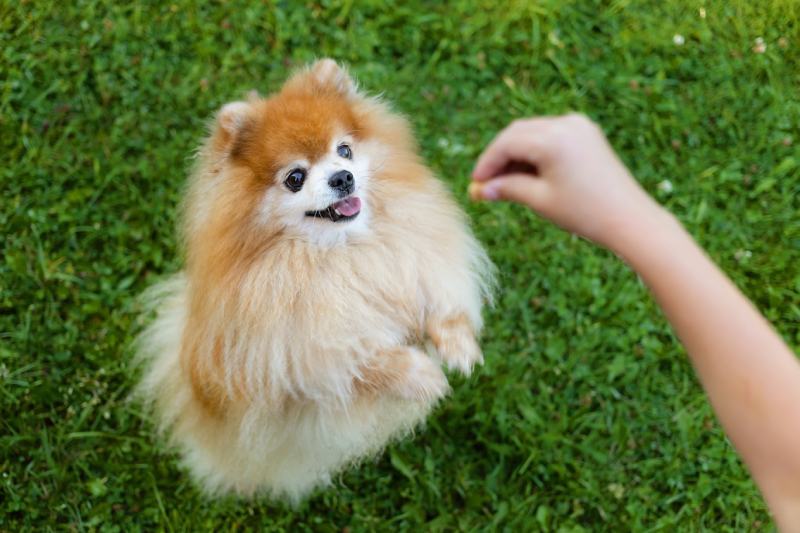
Health and Care
Pomeranians are also typically healthy dogs, as their breeders responsibly check for possible health conditions, such as collapsing tracheas, hypothyroidism, luxating patellas, seizures, congestive heart failure, and alopecia X.
- Patella evaluations
- Ophthalmologist evaluations
- Cardiac exams
Training
Training a Pomeranian is relatively easy, but it can become difficult while trying to housebreak these dogs. Staying consistent and patient is critical, as you’ll need to train it to walk on a leash and come when called from a very young age.
The most important thing to train your Pomeranian is not to jump off high surfaces since it can injure their delicate joints or even break their bones.
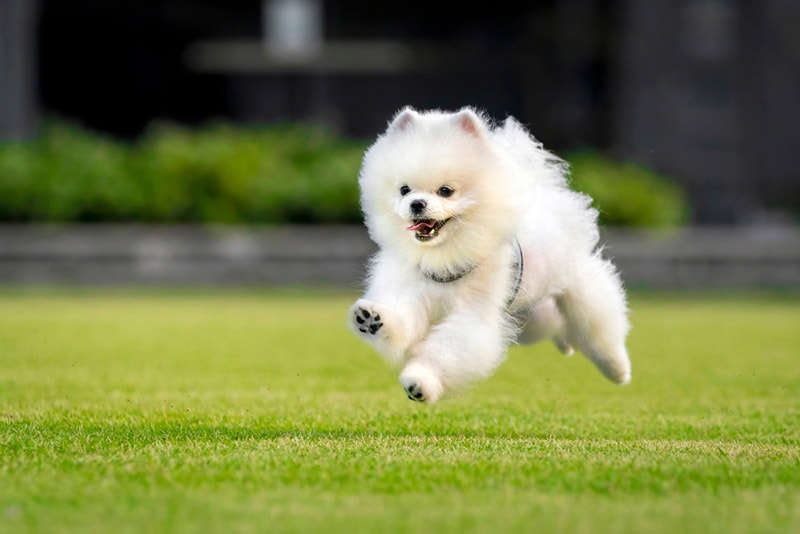
Exercise
Pomeranians only need up to 30 minutes of exercise every day, so they’re ideal for pet owners with a relatively sedentary lifestyle. Their activity can come from daily walks or a quick session of fetch in a safely fenced yard.
It’s crucial to ensure your fence is entirely intact and somewhat high since Pomeranians tend to escape through fence gaps or jump over short fences. Their small size may cause hawks or owls to mistake them for rabbits or squirrels, lowering their chances of survival in the wild.
Grooming
Pomeranians have beautiful and luscious double coats, which causes them to shed everywhere and all the time. You can reduce shedding and matting by remembering to brush their coat with a pin brush or slicker brush every week.
If you have children, trim your Pomeranian’s nails as much as required. Ideally, a monthly trip to the groomer will keep their ears, anal glands, nails, and coats as clean as possible.
Finally, we recommend brushing their teeth with the help of toothpaste designed specifically for dogs.
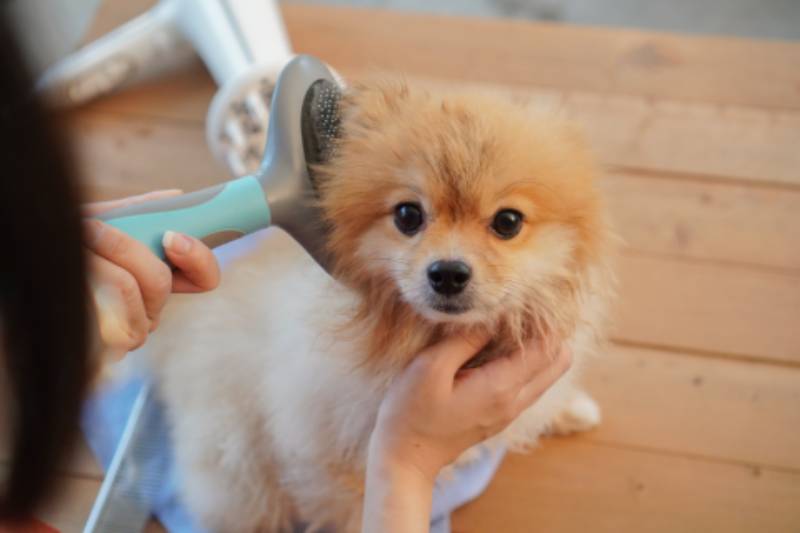
Suitable for:
The Pomeranian is suitable for families in search of a small, loyal, and non-intimidating dog. Their perpetual smiles make them a welcoming sight for children and other dogs, making them the perfect family pet.
Since Pomeranians are incredibly small, allowing them to play with children is safe as long as their nails are trimmed. However, you must remember to teach your children to handle the Pomeranian with care since this dog can be pretty fragile.
- Easy to train
- Good with children
- Can live in the city or suburbs
- Easy to travel with
- Sassy attitude
- High-maintenance grooming needs
- Prone to specific health issues
- Challenging to housebreak
Which Breed Is Right for You?
If you’re hoping to pick your next dog based on its appearance, it may be hard to choose between these two breeds. Although Pomeranians can come in two dozen colors, you’ll most often see them in white, giving them a similar appearance to a Samoyed.
However, since Pomeranians are much smaller than Samoyeds, handling them requires much more delicacy and care. If you have smaller children who haven’t yet been trained to handle smaller dogs, the larger dog breed may be a better fit for you.
Both breeds are relatively high maintenance when it comes to grooming, as they tend to shed a lot, so you’ll need to keep a pet hair cleaner on hand. If you don’t have enough time to exercise your dog daily, a Pomeranian may be a better fit as it only requires half an hour of daily exercise.
On the other hand, Samoyeds require 2 hours of exercise every day. Those who own other dogs may opt for a Samoyed since it can be friendly with other breeds, which is not true with the more miniature Pomeranian.
Most importantly, pet owners living in hot climates cannot own Samoyeds as these dogs are used to northern weather. This breed also does not react well to being confined for too long.
See Also:
- Japanese Spitz vs Pomeranian: Choose the Right One For You
- American Eskimo vs. Pomeranian: Choose the Right One For You
Featured Image Credit: (L) Grisha Bruev, Shutterstock | (R) Trent Pickering, Unsplash



